
Development and Evaluation of Sunscreen Formulations Containing Thai Cinnamon (Cinnamomum bejolghota) Bark Extract and a Cinnamaldehyde-Rich Essential Oil: Sun Protection Potential and Synergistic Effects with Commercial UV Filters
Pakorn Malakaew, Wasika Photharam, and Tasana Pitaksuteepong*Published Date : October 9, 2025
DOI : https://doi.org/10.12982/NLSC.2026.008
Journal Issues : Online First
Abstract Cinnamon bark extract, rich in cinnamaldehyde, possesses antioxidant, anti-tyrosinase, anti-inflammatory, and UVB protection properties. However, its potential as a natural UV filter or its synergy with commercial UV filters remains unexamined. This study aimed to develop and evaluate sunscreen formulations incorporating Cinnamomum bejolghota bark extract for protection against UVB, UVA, and visible light. Two extract types were prepared: crude ethanolic extract (CBE) and water-distilled essential oil (CBO). The cinnamaldehyde content was analyzed using UV-Vis spectrophotometry. CBE showed a higher extraction yield (19.14 ± 0.05%) but a lower cinnamaldehyde content (6.38 ± 0.21%) compared to CBO (0.36 ± 0.04% yield; 79.44 ± 1.32% cinnamaldehyde). Due to the extremely low yield of CBO, further evaluations were conducted using a commercial cinnamaldehyde-rich essential oil with a comparable cinnamaldehyde content (79.01 ± 0.99%), referred to as CBO*. Sunscreen formulations containing 1%–10% CBE or CBO* were assessed for appearance, pH, stability, and sun protection efficacy, expressed as sun protection factor (SPF), ultraviolet A protection factor (UVAPF), and blue light protection. CBE-based formulations exhibited lower SPF values (1.06–1.61) compared to those containing CBO* (4.75–8.72). A 5% CBO* formulation was selected for synergy testing with commercial UV filters: 5% ethylhexyl triazone (UVB filter) and 5% diethylamino hydroxybenzoyl hexyl benzoate (UVA filter). The resulting formulations demonstrated homogeneous textures, pH 6.0–6.7, good stability, and enhanced sunscreen efficacy, with synergistic effects most pronounced when both UV filters were combined. Future studies on photostability and long-term stability are recommended.
Keywords: Cinnamon bark oil, Cinnamaldehyde, Sun Protection Factor, UV Protection, Blue light protection
Grahical Abstract:

Funding: The authors are grateful for the research funding provided by Pharmaceutical Sciences, Naresuan University, Phitsanulok, Thailand.
Citation: Malakaew, P., Photharam, W., and Pitaksuteepong, T. 2025. Development and evaluation of sunscreen formulations containing Thai cinnamon (Cinnamomum bejolghota) bark extract and a cinnamaldehyde-rich essential oil: Sun protection potential and synergistic effects with commercial UV filters. Natural and Life Sciences Communications. 25(1): e2026008.
INTRODUCTION
Ultraviolet (UV) radiation and blue light are the components of sunlight. UV radiation can be divided into three categories: UVC, UVB, and UVA. Due to their limited ability to penetrate the ozone layer, UVC rays may not have as big of an impact on people. UVB rays have wavelengths between 280 and 320 nm. They can penetrate the epidermis and cause the skin to lose moisture, which can result in sunburn (Tang et al., 2024). UVA rays have wavelengths between 320 and 400 nm and can penetrate the epidermis and dermis. Long-term exposure to UVA rays will increase free radical production, which will lower the amount of collagen and elastin in the dermis (Gu et al., 2020). Thus, UVA rays can cause wrinkles, loss of firmness, fine lines, spots, and other signs of premature skin aging. Blue light (BL), also known as high-energy visible (HEV) light, is a specific portion of the visible light (400-800 nm) that falls between 400 and 450 nm. Blue light causes excessive reactive oxygen species (ROS) generation, leading to premature skin aging and hyperpigmentation (dark spots) (Campiche et al., 2020; Suitthimeathegorn et al., 2022).
Sunscreens remain the most effective preventive strategy, but reliance on chemical and physical UV filters raises concerns regarding safety, stability, and long-term efficacy. Consequently, there is growing interest in natural ingredients with photoprotective potential, particularly those that combine UV-absorbing ability with antioxidant, anti-tyrosinase, and anti-inflammatory effects, offering broader skin protection (Tangyuenyongwatana and Gritsanapan, 2022; Tran et al., 2024).
Cinnamon (Cinnamomum spp.) has gained scientific attention for its rich content of bioactive compounds, particularly cinnamaldehyde (El-Baroty et al., 2010; Vangalapati et al., 2012). Various species have demonstrated antioxidant, anti-tyrosinase, and anti-inflammatory properties, along with reported UV-absorbing and SPF-enhancing activities (Marongiu et al., 2007; El-Baroty et al., 2010; Takasao et al., 2012; Chang et al., 2013; Chou et al., 2013; Priani et al., 2014; Han and Parker, 2017; Budiana, 2022; Ulfa et al., 2024). These attributes suggest that cinnamon could serve as a multifunctional ingredient for sunscreen formulations.
Despite promising evidence from other Cinnamomum species, no studies to date have investigated the photoprotective potential of Cinnamomum bejolghota, a Thai cinnamon species. Moreover, existing literature has not addressed its capacity to protect against the full spectrum of UVB, UVA, and blue light, nor explored its performance in combination with commercial UV filters. Therefore, this study aimed to develop and evaluate sunscreen formulations containing C. bejolghota bark crude ethanolic extract and a cinnamaldehyde-rich essential oil, both individually and in combination with commercial UV filters, to explore their potential as photoprotective agents.
MATERIAL AND METHODS
Materials
Cinnamaldehyde standard, purity 97%, was purchased from LGC GmbH (Augsburg, Germany). Commercial cinnamon (Cinnamomum zeylanicum) bark oil was obtained from Krungthepchemi Co., Ltd. (Bangkok, Thailand). Ethanol was purchased from RCI Labscan Limited (Bangkok, Thailand). Two commercial UV filters— Ethylhexyl Triazone (EHT) and Diethylamino Hydroxybenzoyl Hexyl Benzoate (DHHB)—were received from BASF Advanced Chemicals Co., Ltd. (Ludwingshafen, Germany).
Plant material
Dried bark of Thai cinnamon (Cinnamomum bejolghota) aged approximately 10 years was obtained from Baan Suan Chan Herbal Garden, Kanchanaburi Province, Thailand. The botanical identity was confirmed by local herbal experts.
Preparation of cinnamon bark extracts
Crude extract (Ethanolic maceration)
The extraction was performed using the method described by Sukiam et al. (2020) with slight modification. The cinnamon bark was finely ground and macerated in 95% ethanol at a bark-to-solvent ratio of 1:10 at 40°C for 24 hours. The mixture was then filtered, and the filtrate was concentrated using a rotary evaporator (R-300, Buchi, Flawil, Switzerland) to yield the crude extract, which was stored at 4°C until use. The extraction yield was calculated using Equation (1):

Essential oil extraction (Steam distillation)
Steam distillation was attempted using a bark-to-water ratio of 1:6 at 100°C for 5 hours. The aqueous distillate was centrifuged (Beckman J2-MC, Beckman Coulter, Indiana, USA) at 10,000 rpm for 10 min to collect the essential oil and stored in a light-protected container at 4°C until use. The extraction yield was calculated using Equation (1).
Determination of cinnamaldehyde content in the extracts
The determination of cinnamaldehyde content in the extracts was performed using the method described by Rind et al. (2011) with slight modification. A cinnamaldehyde calibration curve was prepared using standard solutions (1–8 µg/mL) in 95% ethanol. Absorbance was recorded at 287 nm using a UV-visible spectrophotometer (UV-1800, Shimadzu, Tokyo, Japan). Both the crude extract and the commercial essential oil were diluted appropriately (1 mg/mL) using 95% ethanol and analyzed similarly. Cinnamaldehyde content was calculated using the standard curve.
Preparation of sunscreen formulations
Base cream
Oil and water phase ingredients (Table 1) were separately heated to 70–75°C. The water phase was maintained 2–3°C higher. The oil phase was slowly added to the water phase under stirring to form an emulsion.
Table 1. Ingredients of base cream.
|
Part |
Ingredients |
|
Water Phase |
Water |
|
|
Carbomer 940 |
|
|
Triethanolamine |
|
|
Niacinamide |
|
|
Disodium EDTA |
|
|
PEG-100 Stearate |
|
|
Glycerin |
|
|
Propylene glycol |
|
Oil phase |
Stearic acid |
|
|
Glyceryl stearate |
|
|
Emulsifying wax NF |
|
|
Caprylic triglycerides |
|
|
Avocado oil |
|
|
Sweet almond oil |
|
|
Phenoxyethanol |
Formulation with cinnamon bark extracts
Crude extract and essential oil were incorporated into the base cream at 1%, 5%, and 10% w/w. These were added at approximately 40°C to the pre-formed emulsion to prevent degradation of volatile constituents.
Formulation with UV filters and Synergistic evaluation
Sunscreen formulations containing 5% w/w of either EHT (UVB filter) or DHHB (UVA filter) were prepared similarly by incorporating them into the oil phase. The cinnamon extract was incorporated into the emulsions at 40°C after emulsification. Formulations were evaluated for potential synergistic effects in terms of photoprotective efficacy.
Evaluation of sunscreen products
Physical characterization
Appearance: The physical appearance of the formulations was observed, assessing whether the formulations remained stable or exhibited phase separation.
pH measurement: The pH of each formulation was measured using a pH meter (SevenDirect SD23, Mettler-Toledo GmbH, Greifensee, Switzerland).
Stability testing
Centrifugation Test: The formulated products were subjected to centrifugation using a high-speed centrifuge (Beckman J2-MC, Beckman Coulter Inc., Indiana, USA) at 3,000 rpm for 30 minutes (Tafuro et al., 2022). Any changes in the formulations were observed after centrifugation.
Heat-Cool Cycling Test: The formulations were placed in glass bottles and subjected to stability testing under alternating temperature conditions: 45°C for 24 hours, followed by 4°C for 24 hours, repeated for six cycles. The formulations were then observed for any stability changes.
Determination of sun protection efficacy
Sun protection factor (SPF)
Transpore Tape® was used as a substrate and placed on an open metal frame supplied with the equipment. The formulation was applied in small dots to the Transpore Tape® over the entire area (i.e., 55 cm2) at 2 mg/cm2 (Chunnawong, 2019). It was then spread evenly using a fingertip. The plate was allowed to equilibrate for 15-30 minutes in the dark. The SPF of the formulations was measured using an SPF-290S analyzer (Optometrics Corporation, USA) that measured spectral transmittance from 290 to 400 nm.
Ultraviolet a protection (UVAPF)
The formulations that showed SPF ≥ 15 were further investigated for UVA and blue light protection. The UVAPF evaluation was conducted in accordance with ISO 24443:2012 (ISO, 2012). Samples (32.5 ± 0.1 g) were applied to 5 × 5 cm PMMA plates and dried in the dark at 25–30 °C for 30 minutes. Subsequently, each plate was placed on the stage of a UV transmittance analyzer (UV–2000S, Labsphere, New Hampshire, USA) and measured at nine different positions to assess UVA (320–400 nm) absorption. The resulting UVAPF0, indicating UVA protective efficiency measured before the irradiation of samples, and the irradiation dose (D) were automatically calculated from the software. Then, the sample plates were irradiated at the dose calculated through a xenon arc lamp from a solar simulator (Suntest CPS+, Atlas Material Testing Technology GmBH, Linsengericht, Germany). After that, the sample plates were again measured, and UVAPF was calculated after irradiation.
Blue light protection
The sample was prepared in the same way as for the UVAPF measurement in order to assess the blue light protection. The UV-2000s transmittance analyzer was used to measure the wavelength at 400–450 nm. From the transmittance spectra, the transmittance values from 400 to 450 nm were used to determine the area under the curve (AUC). Equation 2 (Boyer et al., 2023) was used to determine the percentage of blue light (BL) protection.

Where AUCBL of the sample and AUCBL of the blank plate are the area under the curve, determined from the transmittance spectra from 400 to 450 nm, and are obtained when the sample is applied and not applied on the PMMA plate, respectively.
Statistical analysis
All analyses were performed using one-way analysis of variance (ANOVA) with Bonferroni-Holm post hoc tests using Daniel's XL Toolbox add-in for Excel. A P-value < 0.05 was considered statistically significant.
RESULTS
Characteristics, yield, and cinnamaldehyde content
Crude extract
Figure 1 shows the dark brown crude extract of Cinnamomum bejolghota (Thai cinnamon) bark, which had a yield of 19.14 ± 0.05%. The cinnamaldehyde content in this extract was 6.38 ± 0.21% (Table 2).

Figure 1. Appearance of Cinnamomum bejolghota bark crude extract (CBE) (left), C. bejolghota bark essential oil (CBO) (middle), and cinnamaldehyde-rich C. zeylanicum bark essential oil (CBO*) (right).
Table 2. Cinnamaldehyde content in Cinnamomum bejolghota bark crude extract (CBE), C. bejolghota bark essential oil (CBO), and cinnamaldehyde-rich C. zeylanicum bark essential oil (CBO*).
|
Sample |
Cinnamaldehyde content (%) |
|
CBE |
6.38 ± 0.21 |
|
CBO |
79.44 ± 1.32 |
|
CBO* |
79.01 ± 0.99 |
Essential oil
The essential oil obtained from Thai cinnamon bark by steam distillation was light yellow in color (Figure 1), with a very low yield of 0.36 ± 0.04%. This amount was insufficient for formulation and further evaluation. Therefore, a commercially available Cinnamomum zeylanicum bark essential oil was used as a substitute. This commercial oil was selected based on its comparable cinnamaldehyde content to that of the Thai cinnamon essential oil (Table 2).
Physical characteristics of sunscreen formulations containing cinnamon bark extracts
The formulations evaluated included a base cream (BC) and sunscreen products incorporating C. bejolghota bark crude extract (CBE) or cinnamaldehyde-rich C. zeylanicum bark essential oil (CBO*) at 1%, 5%, and 10% w/w (CBE1, CBE5, CBE10 and CBO*1, CBO*5, CBO*10, respectively). Their visual appearance is shown in Figure 2, and pH is presented in Table 3.
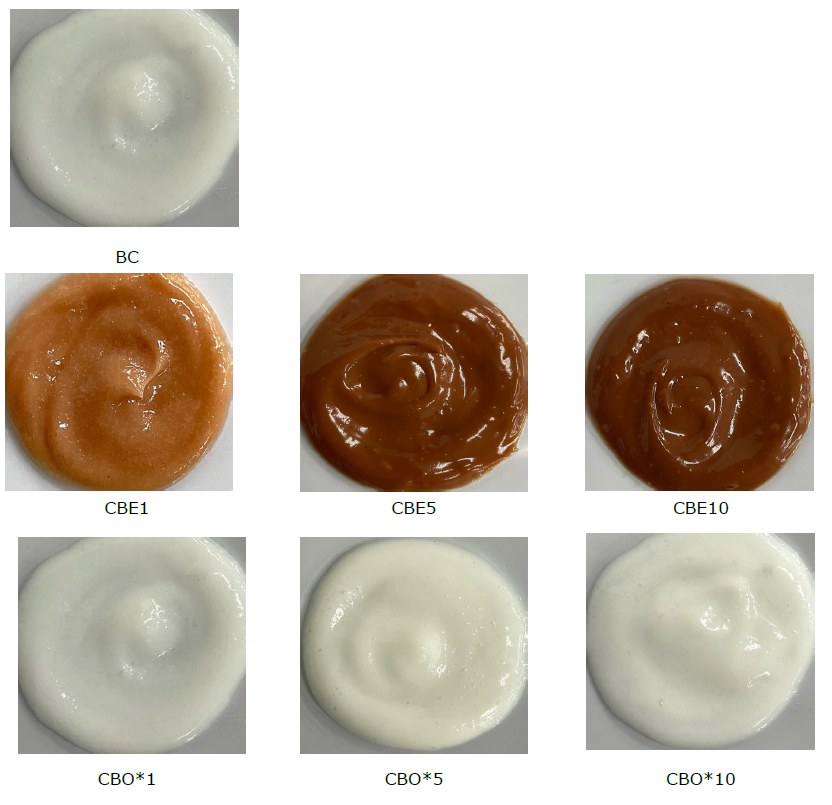
Figure 2. Appearance of base cream (BC) and the sunscreen products containing Cinnamomum bejolghota bark crude extract (CBE) at 1% (CBE1), 5% (CBE5), and 10% (CBE10) by weight as well as cinnamaldehyde-rich C. zeylanicum bark essential oil (CBO*) at 1% (CBO*1), 5% (CBO*5), and 10% (CBO*10) by weight.
All formulations exhibited uniform consistency without phase separation. The intensity of color deepened with increasing concentrations of extract or oil, particularly in CBE10 and CBO*10.
Maintaining skin-compatible pH is essential for preventing irritation, as products with a pH ≤ 2.5 or ≥ 8 can cause dryness or discomfort. Ideal pH is around 6.0, which approximates the average pH of healthy skin (Geoffrey et al., 2019). All formulations exhibited pH values ranging from 5.9 to 6.6, falling within the acceptable range for cosmetic applications.
After centrifugation and heat–cool cycling, the products remained physically stable, with no evidence of phase separation or structural degradation.
Table 3. pH of the base cream (BC) and the sunscreen products containing Cinnamomum bejolghota bark crude extract (CBE) at 1% (CBE1), 5% (CBE5), and 10% (CBE10) by weight, as well as cinnamaldehyde-rich C. zeylanicum bark essential oil (CBO*) at 1% (CBO*1), 5% (CBO*5), and 10% (CBO*10) by weight.
|
Samples |
pH |
|
BC |
6.64 ± 0.03 |
|
CBE1 |
6.17 ± 0.08 |
|
CBE5 |
6.40 ± 0.04 |
|
CBE10 |
6.09 ± 0.12 |
|
CBO*1 |
6.57 ± 0.05 |
|
CBO*5 |
6.38 ± 0.03 |
|
CBO*10 |
5.91 ± 0.15 |
Sun protection efficacy of cinnamon bark extracts
The sun protection efficacy of the formulated sunscreens was first evaluated through in vitro SPF measurements. The SPF of base cream and sunscreen product formulations of CBE and CBO* at concentrations of 1%, 5%, and 10%, respectively, are shown in Figure 3. It was found that sunscreen products containing CBE at concentrations of 1%, 5%, and 10% by weight had sun protection efficacy values of 1.06 ± 0.02, 1.41 ± 0.03, and 1.61 ± 0.06, respectively. This value was less than the sun protection efficacy values of the sunscreen products prepared with CBO* at concentrations of 1% (4.75 ± 0.27), 5% (5.07 ± 0.13), and 10% (8.72 ± 0.23) by weight. The combination of these extracts in the base cream provided higher sun protection efficacy depending on the amount of mixture but not directly in proportion. Therefore, only the formulation combined with CBO* at 5% by weight was selected for further study.
Study of the sun protection efficacy between cinnamaldehyde-rich
C. zeylanicum bark essential oil (CBO*) and commercially sunscreen agents
According to Chunnawong (2019), ethylhexyl triazone (EHT, UVB filter) and diethylamino hydroxybenzoyl hexyl benzoate (DHHB, UVA filter) are commonly used UV filters in commercial sunscreen products. EHT and DHHB exhibit absorption maxima (λ max) at 314 nm and 354 nm, respectively, with A (1%, 1 cm) values of 1,890.5 ± 17.6 and 1,174.6 ± 13.8. To assess potential synergy, these filters were each combined with 5% CBO* at a fixed concentration of 5% w/w.
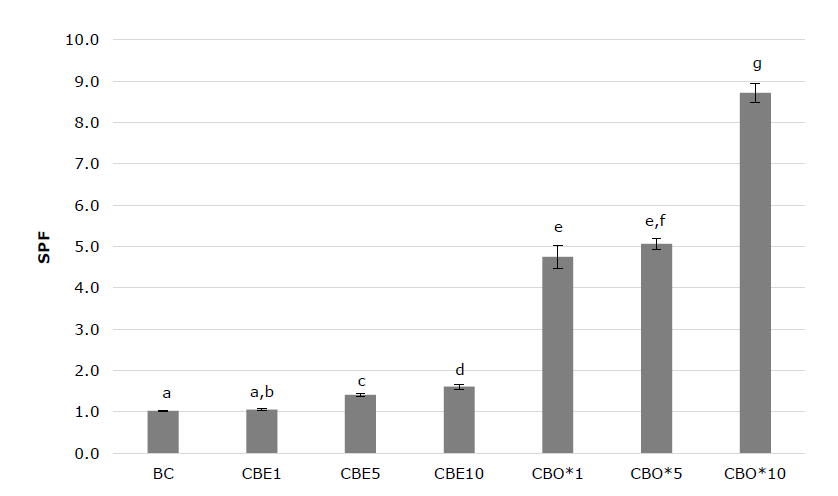
Figure 3. SPF values of base cream (BC) and the sunscreen products containing Cinnamomum bejolghota bark crude extract (CBE) at 1% (CBE1), 5% (CBE5), and 10% (CBE10) by weight as well as cinnamaldehyde-rich C. zeylanicum bark essential oil (CBO*) at 1% (CBO*1), 5% (CBO*5), and 10% (CBO*10) by weight. The results were expressed as mean ± standard deviation (n = 3) and bar graphs with different letters indicate statistical differences at a confidence level of 0.05.
Physical characteristics of combined sunscreen formulations
All combinations of CBO* with EHT and/or DHHB yielded homogeneous formulations with a white to yellow appearance (Figure 4). The pH values of these formulations ranged from 6.4 to 6.8 (Table 4), which was within an acceptable range for cosmetic applications, ensuring compatibility with the skin and reducing the risk of irritation. Following centrifugation and heat-cool cycling tests, no signs of instability (i.e., no phase separation, pH change, or color change) were observed.
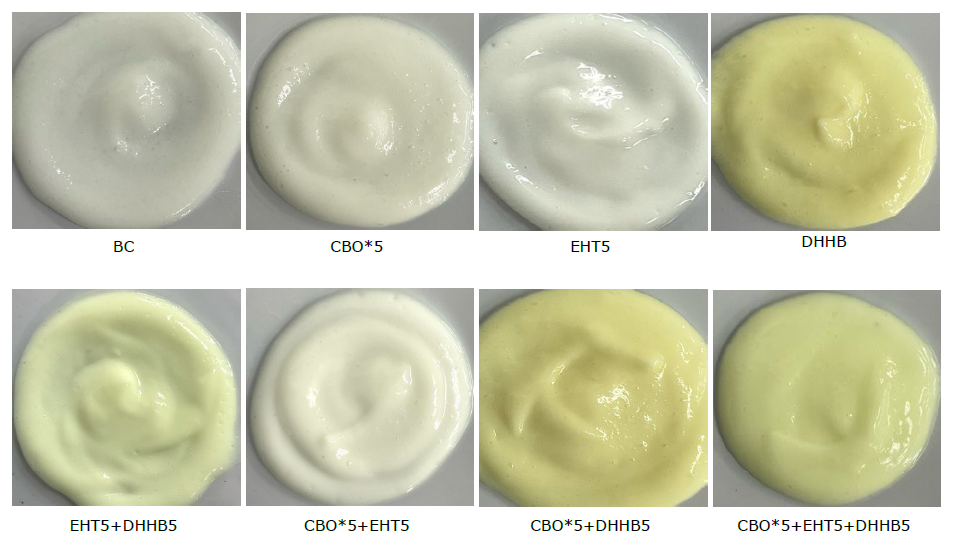
Figure 4. Appearance of the base cream (BC) and the sunscreen products containing cinnamaldehyde-rich Cinnamomum zeylanicum bark essential oil (CBO*5), ethylhexyl triazone (EHT5), and/or diethylamino hydroxybenzoyl hexyl benzoate (DHHB5) at 5% by weight.
Table 4. pH of the sunscreen formulations containing cinnamaldehyde-rich C. zeylanicum bark essential oil (CBO*), ethylhexyl triazone (EHT), and/or diethylamino hydroxybenzoyl hexyl benzoate (DHHB) at 5% by weight.
|
Sunscreen products |
pH |
|
CBO*5 |
6.38 ± 0.03 |
|
EHT5 |
6.67 ± 0.01 |
|
DHHB5 |
6.49 ± 0.08 |
|
EHT5+DHHB5 |
6.51 ± 0.03 |
|
CBO*5+EHT5 |
6.51 ± 0.02 |
|
CBO*5+DHHB5 |
6.77 ± 0.03 |
|
CBO*5+EHT5+DHHB5 |
6.54 ± 0.01 |
Sun protection factor (SPF) of combined formulations
The SPF values of the base cream (BC) formulation and the sunscreen products with various active ingredients at 5% by weight each are shown in Figure 5. The base cream exhibited the lowest SPF, consistent with its lack of UV-blocking agents. The SPF was considerably raised by the addition of CBO*, and it was higher than that of the formulations that contained DHHB or EHT alone. Notably, the combination of CBO* and DHHB exhibited synergistic effects, achieving higher SPF than the EHT+DHHB or CBO*+EHT combinations. The highest SPF was observed in the formulation combining CBO*, EHT, and DHHB.
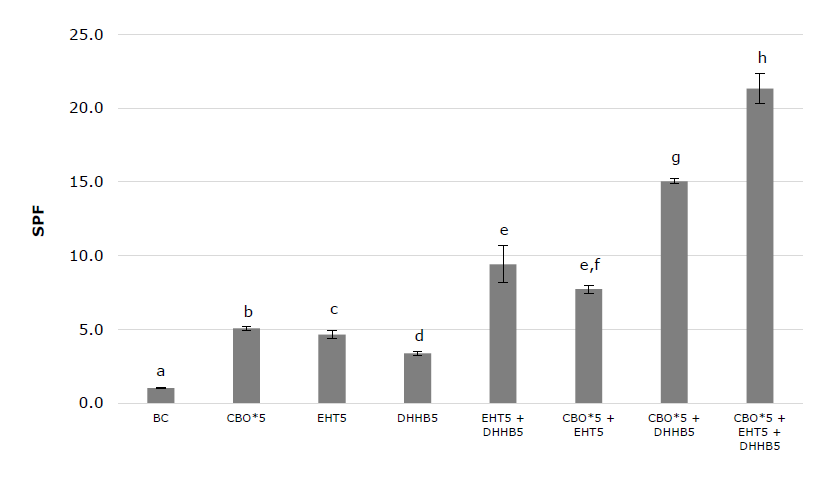
Figure 5. SPF values of base cream (BC) and the sunscreen products containing cinnamaldehyde-rich Cinnamomum zeylanicum bark essential oil (CBO*5), ethylhexyl triazone (EHT), and/or diethylamino hydroxybenzoyl hexyl benzoate (DHHB) at 5% by weight. The results were expressed as mean ± standard deviation (n = 3) and bar graphs with different letters indicate statistical differences at a confidence level of 0.05.
UVA and blue light protection
Table 5 summarizes UVA protection factor (UVAPF), critical wavelength (λc), and blue light protection percentages. The combination of 5% CBO* and 5% DHHB resulted in a UVAPF of 9.10 and a critical wavelength of 375.94 nm, indicating good broad-spectrum protection. However, the addition of EHT (CBO*5+EHT5+DHHB5) increased overall SPF but decreased the UVAPF to 5.73, suggesting a relative shift toward UVB protection. The formulations provided low blue light protection, with a maximum of 4.10% observed in the CBO*5+EHT5+DHHB5 formulation.
Table 5. Sun protection factor (SPF), ultraviolet a protection factor (UVAPF), Critical wavelength (λc), and blue light (BL) protection.
|
Sample |
SPF |
UVAPF |
λc (nm) |
%BL |
|
CBO*5+DHHB5 |
15.04 ± 0.17 |
9.10 |
375.94 |
1.00 |
|
CBO*5+EHT5+DHHB5 |
21.32 ± 1.00 |
5.73 |
375.61 |
4.10 |
DISCUSSION
Cinnamon bark essential oil demonstrated a significantly higher cinnamaldehyde content than the crude extract, aligning with its more pronounced photoprotective effect. Cinnamaldehyde's chemical structure is made up of a benzene ring (phenyl group) linked to a carbon-carbon double bond and an aldehyde group (CHO) (Figure 6). The conjugated double bond, C=O carbonyl group, and aromatic ring are chromophores that absorb light in the ultraviolet and visible spectrums, contributing to UV-filtering capacity.
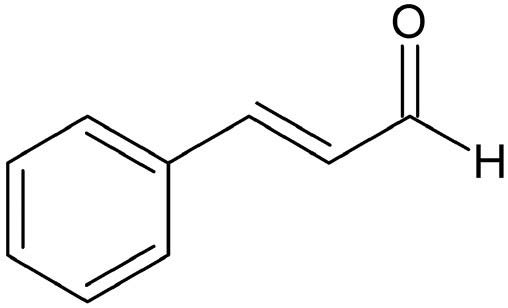
Figure 6. Chemical structure of cinnamaldehyde.
Incorporation of cinnamaldehyde-rich essential oil (CBO*) into sunscreen formulations enhanced both cosmetic acceptability and functional performance. Its known biological activities—including UV absorption, antioxidant, anti-inflammatory, and tyrosinase-inhibitory properties—support its potential as a multifunctional sunscreen additive. Specifically, antioxidant activity can neutralize reactive oxygen species generated by UV and blue light exposure, reducing oxidative stress and preventing premature skin aging; anti-inflammatory effects may mitigate UV-induced dermal inflammation; and tyrosinase inhibition can help prevent hyperpigmentation and dark spot formation. These complementary properties provide additional skin protection beyond UV filtering alone.
The observed SPF enhancement in CBO*-based formulations was dose-dependent, though not strictly proportional, suggesting saturation or interaction effects at higher concentrations. These findings are consistent with the photoprotective role of cinnamaldehyde and related compounds (Tanaka et al., 2019).
The combination of CBO* with commercial UV filters—ethylhexyl triazone (EHT, a UVB filter) and diethylamino hydroxybenzoyl hexyl benzoate (DHHB, a UVA filter)—demonstrated additive and potentially synergistic effects. The formulation containing CBO*5+EHT5+DHHB5 achieved the highest SPF among all tested, highlighting the potential of CBO* as a natural SPF booster in combination with conventional agents.
Beyond UVB protection, this study also evaluated the formulations' ability to protect against UVA and blue light. UVA radiation penetrates the dermis and is implicated in photoaging and carcinogenesis, while blue light exposure can induce oxidative stress and hyperpigmentation. The CBO*5+DHHB5 formulation provided strong UVA protection, evidenced by a high UVA protection factor (UVAPF = 9.10) and a critical wavelength (λc) of 375.94 nm, meeting the threshold for broad-spectrum protection (λc ≥ 370 nm). The strong UVA coverage is likely enhanced by the lipophilic and aromatic nature of DHHB and cinnamaldehyde-based compounds in CBO*.
Interestingly, the ternary combination (CBO*5+EHT5+DHHB5) showed a higher SPF but a lower UVAPF (5.73) compared to the binary CBO*5+DHHB5 formulation. This indicates that while EHT enhances UVB protection, its inclusion may dilute or overshadow the UVA-boosting effect of the binary system. Therefore, formulation balance is crucial to achieving broad-spectrum coverage.
Notably, all tested formulations exhibited minimal protection against blue light, with a maximum efficacy of 4.10%. Although direct blue light protection was limited, the antioxidant and anti-inflammatory properties of essential oil may still mitigate blue light-induced oxidative stress and cellular damage, suggesting potential benefits for long-term skin health. Further formulation strategies incorporating blue light-specific filters or complementary antioxidants may be required to improve protection in this spectrum.
Overall, these findings demonstrate that while the crude extract offered only modest UV protection, the essential oil exhibited superior efficacy, highlighting the role of cinnamaldehyde as a key active compound. The cinnamaldehyde-rich bark essential oil not only enhanced SPF and broad-spectrum UV protection when combined with conventional filters but also provided additional multifunctional benefits derived from its bioactive constituents. Such properties make cinnamaldehyde-rich bark essential oil a promising natural ingredient for sunscreen formulations that aim to combine photoprotection with skin health-promoting effects. A major limitation of this work was the insufficient yield of C. bejolghota essential oil, which necessitated the use of C. zeylanicum essential oil as a representative cinnamaldehyde-rich source. Future studies should focus on optimizing extraction methods to obtain sufficient quantities of C. bejolghota essential oil, enabling direct comparative evaluation and expanding its potential application in cosmeceutical development.
CONCLUSION
This study demonstrates the potential of cinnamaldehyde-rich essential oil as a natural photoprotective agent in sunscreen formulations. While conventional UV filters such as EHT and DHHB remain the primary contributors to SPF, the incorporation of cinnamaldehyde-rich essential oil enhances UVB protection and contributes to broad-spectrum efficacy, particularly in combination with DHHB. Cinnamaldehyde-rich essential oil also offers favorable cosmetic properties and formulation stability. However, its limited effect on blue light protection highlights the need for further formulation optimization. Future studies involving photostability, long-term stability, in vivo efficacy, and safety evaluation are warranted to support its application in commercial sunscreen products.
ACKNOWLEDGEMENTS
The authors thank the Faculty of Pharmaceutical Sciences, Naresuan University for providing financial support and facilities. Thanks to Mr. Pan Sathanthung, Mr. Somkiet Chaiphan, and Ms. Sakawrat Taptonglang, the scientists of the Faculty of Pharmaceutical Sciences, Naresuan University; and Ms. Supaporn Tuanthai, the scientist of the Cosmetics and Natural Products Research Center, Naresuan University, for the technical support.
AUTHOR CONTRIBUTIONS
Pakorn Malakaew and Wasika Photharam designed and conducted the experiments and data analysis. Tasana Pitaksuteepong designed the experiments, supervised the project, and wrote the manuscript. All authors have read and approved the final manuscript.
CONFLICT OF INTEREST
The authors declare that they hold no competing interests.
REFERENCES
Boyer, F., Delsol, C., Ribet, V., and Lapalud, P. 2023. Broad‐spectrum sunscreens containing the TriAsorB™ filter: In vitro photoprotection and clinical evaluation of blue light‐induced skin pigmentation. Journal of the European Academy of Dermatology and Venereology. 37: 12-21. https://doi.org/10.1111/jdv.19290
Budiana, I.G.M.N. 2022. Isolation and sunscreen activity test of cinnamon oil from Flores Island, Indonesia. American Scientific Research Journal for Engineering, Technology, and Sciences. 90(1): 405-413.
Campiche, R., Curpen, S.J., Lutchmanen-Kolanthan, V., Gougeon, S., Cherel, M., Laurent, G., Gempeler, M., and Schuetz, R. 2020. Pigmentation effects of blue light irradiation on skin and how to protect against them. International Journal of Cosmetic Science. 42(4): 399-406. https://doi.org/10.1111/ics.12637
Chang, C.T., Chang, W.L., Hsu, J.C., Shih, Y., and Chou, S.T. 2013. Chemical composition and tyrosinase inhibitory activity of Cinnamomum cassia essential oil. Botanical Studies. 54(1): 10. https://doi.org/10.1186/1999-3110-54-10
Chou, S.T., Chang, W.L., Chang, C.T., Hsu, S.L., Lin, Y.C., and Shih, Y. 2013. Cinnamomum cassia essential oil inhibits α-MSH-induced melanin production and oxidative stress in murine B16 melanoma cells. International Journal of Molecular Sciences. 14(9): 19186-19201. https://doi.org/10.3390/ijms140919186
Chunnawong, O. 2019. The development and evaluation of sunscreen product for UV-Visible protection. Master's thesis. Naresuan University, Phitsanulok, Thailand.
El-Baroty, G.S., Abd El-Baky, H.H., Farag, R.S., and Saleh, M.A. 2010. Characterization of antioxidant and antimicrobial compounds of cinnamon and ginger essential oils. African Journal of Biochemistry Research. 4(6): 167-174.
Geoffrey, K., Mwangi, A.N., and Maru, S.M. 2019. Sunscreen products: Rationale for use, formulation development and regulatory considerations. Saudi Pharmaceutical Journal. 27(7): 1009-1018. https://doi.org/10.1016/j.jsps.2019.08.003
Gu, Y., Han, J., Jiang, C., and Zhang, Y. 2020. Biomarkers, oxidative stress and autophagy in skin aging. Ageing Research Reviews. 59(5765): 101036. https://doi.org/10.1016/j.arr.2020.101036
Han, X. and Parker, T.L. 2017. Antiinflammatory activity of cinnamon (Cinnamomum zeylanicum) bark essential oil in a human skin disease model. Phytotherapy Research. 31(7): 1034-1038. https://doi.org/10.1002/ptr.5822
ISO, I.O.f.S. 2012. Determination of sunscreen UVA photoprotection in vitro (ISO 24443:2012).
Marongiu, B., Piras, A., Porcedda, S., Tuveri, E., Sanjust, E., Meli, M., Sollai, F., Zucca, P., and Rescigno, A. 2007. Supercritical CO2 extract of Cinnamomum zeylanicum: Chemical characterization and antityrosinase activity. Journal of Agricultural and Food Chemistry. 55(24): 10022-10027. https://doi.org/10.1021/jf071938f
Priani, S.E., Humanisya, H., and Darusman, F. 2014. Development of sunscreen emulgel containing Cinnamomum Burmannii stem bark extract. International Journal of Science and Research. 3(12): 2319-7064.
Rind, F.M.A., Memon, A.H., Almani, F.A., Laghari, M.G.H., Mughal, U.R., Maheshwari, M.L., and Khuhawar, M.Y. 2011. Spectrophotometric determination of cinnamaldehyde from crude drugs and herbal preparations. Asian Journal of Chemistry. 23(2):631-635.
Suitthimeathegorn, O., Yang, C., Ma, Y., and Liu, W. 2022. Direct and indirect effects of blue light exposure on skin: A review of published literature. Skin Pharmacology and Physiology. 35(6): 305-318. https://doi.org/10.1159/000526720
Sukaim, J., Phonprapai, C., Oontawee, S., and Chanthon, S. 2020. Activities of cinnamon bark extract on antioxidant and alpha-glucosidase inhibition. Thai Journal of Science and Technology. 9(5): 559-667.
Tafuro, G., Di Domenico, E., Costantini, A., Francescato, S., Busata, L., Baratto, G., and Semenzato, A. 2022. Stability and application properties of surfactant-free cosmetic emulsions: An instrumental approach to evaluate their potential. Cosmetics. 9(6): 123. https://doi.org/10.3390/cosmetics9060123
Takasao, N., Tsuji-Naito, K., Ishikura, S., Tamura, A., and Akagawa, M. 2012. Cinnamon extract promotes type I collagen biosynthesis via activation of IGF-I signaling in human dermal fibroblasts. Journal of Agricultural and Food Chemistry. 60(5): 1193-1200. https://doi.org/10.1021/jf2043357
Tanaka, Y., Uchi, H., and Furue, M. 2019. Antioxidant cinnamaldehyde attenuates UVB-induced photoaging. Journal of Dermatological Science. 96(3): 151-158. https://doi.org/10.1016/j.jdermsci.2019.11.001
Tang, X., Yang, T., Yu, D., Xiong, H., and Zhang, S. 2024. Current insights and future perspectives of ultraviolet radiation (UV) exposure: Friends and foes to the skin and beyond the skin. Environment International. 185: 108535. https://doi.org/10.1016/j.envint.2024.108535
Tangyuenyongwatana, P. and Gritsanapan, W. 2022. Development of sunscreen containing alpha-mangostin riched extract with anti-tyrosinase activities. Chiang Mai University Journal of Natural Sciences. 21(4): e2022064. https://doi.org/10.12982/CMUJNS.2022.064
Tran, T.P.A., Tran, T.T.V., Pham, T.L., and Phan, T.K.V. 2024. Potential use of polyphenol-enriched extract from Moringa oleifera leaves as an active ingredient in sunscreen. Natural and Life Sciences Communications. 23(2): 1-18. https://doi.org/10.12982/NLSC.2024.016
Ulfa, R., Firmansyah, F., Khairunnisa, F., and Lestari, P. 2024. A literature review on the formulation, characterization, and stability of Cinnamomum burmannii emulgel extract as an antioxidant and sunscreen. Jurnal Ilmu Farmasi dan Farmasi Klinik. 21(1): 48. https://doi.org/10.31942/jiffk.v21i1.9126
Vangalapati, M., Satya, N.S., Prakash, D.V.S., and Avanigadda, S. 2012. A Review on pharmacological activities and clinical effects of Cinnamon species. Research Journal of Pharmaceutical, Biological and Chemical Sciences. 3(1): 653-663.
OPEN access freely available online
Natural and Life Sciences Communications
Chiang Mai University, Thailand. https://cmuj.cmu.ac.th
Pakorn Malakaew1, Wasika Photharam1, and Tasana Pitaksuteepong1, 2, *
1 Department of Pharmaceutical Technology, Faculty of Pharmaceutical Sciences, Naresuan University, Phitsanulok 65000, Thailand.
2 Center of Excellence for Innovation in Chemistry, Naresuan University, Phitsanulok 65000, Thailand.
Corresponding author: Tasana Pitaksuteepong, E-mail: tasanap@nu.ac.th
ORCID iD: Tasana Pitaksuteepong: https://orcid.org/0000-0001-5641-5430
Total Article Views
Editor: Wipawadee Yooin,
Sirasit Srinuanpan,
Chiang Mai University, Thailand
Article history:
Received: May 8, 2025;
Revised: August 20, 2025;
Accepted: October 1, 2025;
Online First: October 9, 2025

